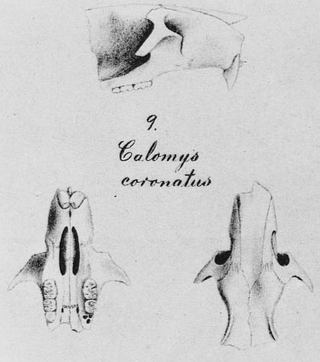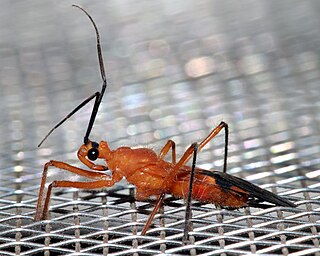
The subfamily Deomyinae consists of four genera of mouse-like rodents that were previously placed in the subfamilies Murinae and Dendromurinae. They are sometimes called the Acomyinae, particularly in references that antedate the discovery that the link rat, Deomys ferugineus, is part of the clade. Deomyinae is the older name and therefore has priority over Acomyinae.

The term spiky mouse refers to any species of rodent within the genus Acomys. Similar in appearance to mice of the genus Mus, spiky mice are small mammals with bare tail which contains osteoderms, a rare feature in mammals.It was found on 20 February 2013 Their coats are endowed with unusually stiff guard hairs similar to the spikes of a hedgehog; this trait is the source of the common name, spiky mouse.

Batomys is a genus of rodent endemic to the Philippines. It has six extant described species.

The golden spiny mouse gets its name from the reddish-orange spiny fur that covers its body from head to tail. This coarse, inflexible fur is thought to protect it from predation. Aside from the golden fur that covers its head and upper parts, its flanks are yellow and its underside is pale. It has gray legs with pale feet and black soles. It is also described as having a small, but distinct white spot under each eye. It is often found in the wild missing a part or all of its tail because it is able to shed this as a defense mechanism. However, it is not known how this is done, how often it can occur, or under what conditions. It lives an average of three years in the wild. It is omnivorous and feeds on seeds, desert plants, snails, and insects. Living in desert regions, it is a xeric animal that obtains water from the plants that it eats and produces very concentrated urine in order to conserve water. A. russatus is naturally nocturnal, but adapts to being diurnal when it shares a habitat with A. cahirinus.

Mantius is a spider genus of the jumping spider family, Salticidae.

Euryoryzomys emmonsae, also known as Emmons' rice rat or Emmons' oryzomys, is a rodent from the Amazon rainforest of Brazil in the genus Euryoryzomys of the family Cricetidae. Initially misidentified as E. macconnelli or E. nitidus, it was formally described in 1998. A rainforest species, it may be scansorial, climbing but also spending time on the ground. It lives only in a limited area south of the Amazon River in the state of Pará, a distribution that is apparently unique among the muroid rodents of the region.

Euryoryzomys russatus, also known as the russet oryzomys, russet rice rat, or big-headed rice rat, is a species of rodent in the family Cricetidae. It is a member of the genus Euryoryzomys, which was split off from Oryzomys in 2006. It was first described by Johann Andreas Wagner in 1848. It is found in southern Brazil, eastern Paraguay and northeastern Argentina. It is considered a large species in its genus, with a reddish-brown coat, long tail length, and large skull. It is a terrestrial rodent, spending its time foraging for seeds, fruits, and insects. It is listed by the IUCN as least concern, although studies have shown it to be influenced by anthropogenic disturbances. Predators consist of small members of the order Carnivora.

Chlorostilbon is a genus of hummingbird in the family Trochilidae, known as emeralds. A single species, the blue-chinned sapphire is variously placed in the monotypic genus Chlorestes or in Chlorostilbon. The taxonomy of the C. mellisugus superspecies is highly complex and, depending on view, includes 1-8 species. All species in this genus have straight black or black-and-red bills. The males are overall iridescent green, golden-green or bluish-green, and in some species the tail and/or throat is blue. The females have whitish-grey underparts, tail-corners and post-ocular streak.

The ruddy tody-flycatcher is a species of bird in the family Tyrannidae.
The russet free-tailed bat is a species of bat in the family Molossidae. It is found in Cameroon, Democratic Republic of the Congo, Ghana, and Kenya. Its natural habitat is subtropical or tropical moist lowland forests.
Russatus nigrescens is a species of small air-breathing land snail, a terrestrial pulmonate gastropod mollusk in the family Charopidae. This species is endemic to Micronesia.

Charopidae is a taxonomic family of small air-breathing land snails, terrestrial pulmonate gastropod mollusks in the superfamily Punctoidea.

Mops is a genus of bats in the family Molossidae. Molecular sequence data indicates that Mops and Chaerephon are not monophyletic taxa. However, the grouping of Chaerephon and Mops was found to be monophyletic when excluding C. jobimena.

Melese is a genus of moths in the family Erebidae. The genus was erected by Francis Walker in 1854.
The tody-flycatchers are several species of birds in the family Tyrannidae:

Euryoryzomys is a genus of rodents in the tribe Oryzomyini of family Cricetidae. It includes seven species, which are distributed in South America. Until 2006, its members were included in the genus Oryzomys, but they are not closely related to the type species of that genus, and therefore they were placed in a new genus. They are most closely related to genera like Hylaeamys and Transandinomys; many members of these genera were previously placed in a single species, known as Oryzomys capito. The genus name, Euryoryzomys, combines the name "Oryzomys" with the Ancient Greek word eurus "broad", referring to the broad range in distribution of the genus.

Dinagat hairy-tailed rat or russet batomys is one of five species of rodent in the genus Batomys. It is in the diverse family Muridae. This species is endemic to the Philippines.

Hygroplitis is a genus of braconid wasps in the family Braconidae. There are about nine described species in Hygroplitis, found in the Holarctic.

Cydnocoris is a genus of assassin bugs found in tropical Asia. It has been suggested that this genus be either treated as a synonym of CutocorisStål, 1859 or the later name be suppressed.














